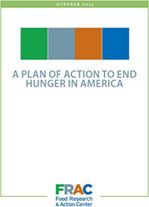Published May 1, 2025
There is a proposal in Congress to shift the costs of the Supplemental Nutrition Assistance Program (SNAP) from the federal government to the states. Currently, the federal government funds 100 percent of the SNAP benefit and splits state administration costs 50/50. Details are minimal on what the shift would look like, but a recent proposal shows a phased 22.5 percent shift to states by 2034. While President Trump may be wary of a cost shift, here are nine things to remember as advocates continue to push back against this proposal.
1. Cost-Shifting to States Creates Unfunded Mandates
This proposal is an unfunded federal mandate, forcing states to raise taxes or cut other essential services to cover SNAP costs. Most states already struggle with chronic understaffing and underfunding across SNAP administering agencies. Coupled with program complexities, this would increase timeliness delays and payment errors.
2. States Do Not Have the Budget for This
State budgets are tied to obligations like health care, education, and infrastructure. States do not have the financial capacity to absorb additional SNAP costs, even if they have a surplus. A state with a budget surplus does not mean it can use those funds toward SNAP. That is because it is unanticipated, so utilizing a surplus for a recurring commitment is simply fiscally irresponsible. Legislatures tend to prefer using surpluses as one-time spending to, for example, pay for:
- infrastructure projects (Mississippi),
- improving financial stability (Oklahoma), or
- funding new schools (Idaho).
3. People With Low Incomes Would Be Removed From SNAP
Shifting costs from other state obligations is unlikely and undesirable. This leaves two options for states. States would be forced to choose between raising taxes — an unpopular move in any economic climate — or cutting vital state options like “broad-based categorical eligibility” (SNAP expansion), which helps over 3 million people afford food. Cutting this option would drive up food insecurity and reduce revenue in local economies, which negatively impacts state budgets. It would also remove children’s direct certification for free school meals and WIC. It is important to note that removing SNAP expansion is one of Project 2025’s goals.
4. Cutting SNAP Would Reduce Economic Growth
Every $1 in SNAP benefits generates up to $1.80 in local economic activity during economic downturns, supporting farmers, grocery stores, and small businesses — many in rural districts. If states have to cut benefits or delay processing, fewer dollars go into local economies, hurting small-town grocers, family-owned stores, and farmers while also increasing food insecurity. SNAP is also critical during times of recession — a time when states’ revenues plummet and they need programs like SNAP to drive economic growth while taking care of residents’ basic needs.
5. Removing Funding Would Increase Errors
Some in Congress want to pursue this unfunded mandate to punish states for payment errors, claiming states do not have skin in the game. This ignores the fact that a payment error penalty currently exists. If a state’s SNAP payment error rate exceeds the national payment error rate two years in a row, then the state must pay a fine to the U.S. Department of Agriculture (USDA) or invest 50 percent of the fine to improve the state’s SNAP administration. The remaining 50 percent is held and paid to the USDA only if the state continues to have high payment errors the next year. This creates an incentive for states to adopt improvements, trainings, etc., to retain that 50 percent. Penalizing states for error rates by shifting costs permanently to them not only diverts resources away from fixing those errors but also creates a cycle of underfunded administrations, which leads to worsening performance, which leads to increased payment errors.
6. A Cost Shift Would Increase Burdens, Not Reduce Errors
Many errors happen due to complex federal rules and underfunded, understaffed agencies, not state mismanagement. Instead of cutting funds, Congress should simplify eligibility rules and improve funding for agencies to prevent errors at the root. A well-funded program reduces waste and saves taxpayer dollars, while cutting funding would reverse that and increase food insecurity, as families’ applications would not be reviewed in a timely manner.
7. Some States Would Be Punished More Than Others
Many high-error-rate states are rural and Southern, which have high poverty and food insecurity (e.g., Florida, Kansas, South Carolina, and Tennessee all had higher-than-average payment error rates). With their limited state budgets, they would not be able to cover additional costs, leading to their residents suffering more than people in other states. When lives are on the line, receiving basic needs in the wealthiest country in the world should not be based on a state’s performance.
8. Error Prevention Should Be the Focus — Not Cost-Shifting
If error rates are the concern, then Congress should invest in merit-based staff and technological upgrades that favor interoperability between programs rather than cutting administrative funding. Penalizing states by shifting costs to them does not reduce errors — it would worsen errors by underfunding the very agencies that detect and prevent them.
9. Without SNAP, Families Would Need More Costly Programs
When families can’t access food, they turn to emergency rooms, food pantries, and soup kitchens, which are far more expensive to taxpayers than SNAP, and sometimes inaccessible. If SNAP is weakened, states would see increased Medicaid costs, higher rates of child malnutrition, and more reliance on food banks — shifting costs in ways that not only hurt state and local budgets, but also hurt the future of this nation.
Cost-shifting SNAP to states is not reform — it is abandonment. Congress cannot lead the people if it cannot feed the people. If the goal is reducing payment errors, then they must go to the root of the cause. Reduce program complexities and fully fund states to meet their staffing needs. Advocates can act now by writing to your Member of Congress and telling them not to make any cuts to SNAP.


